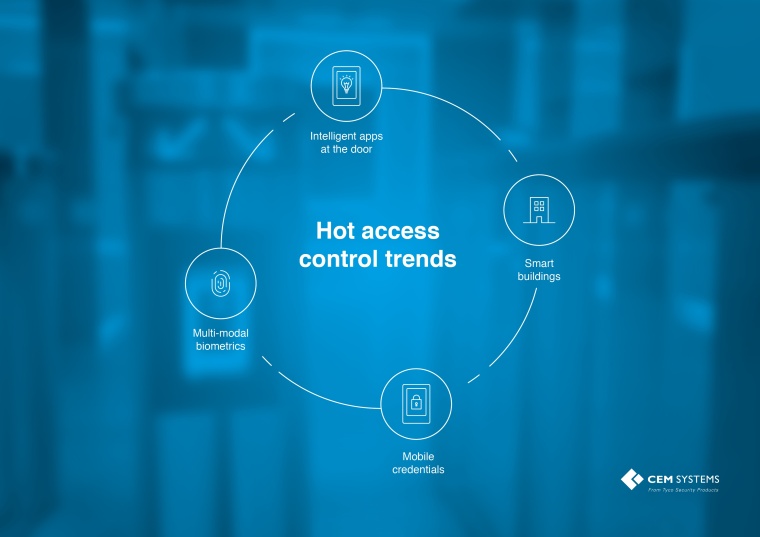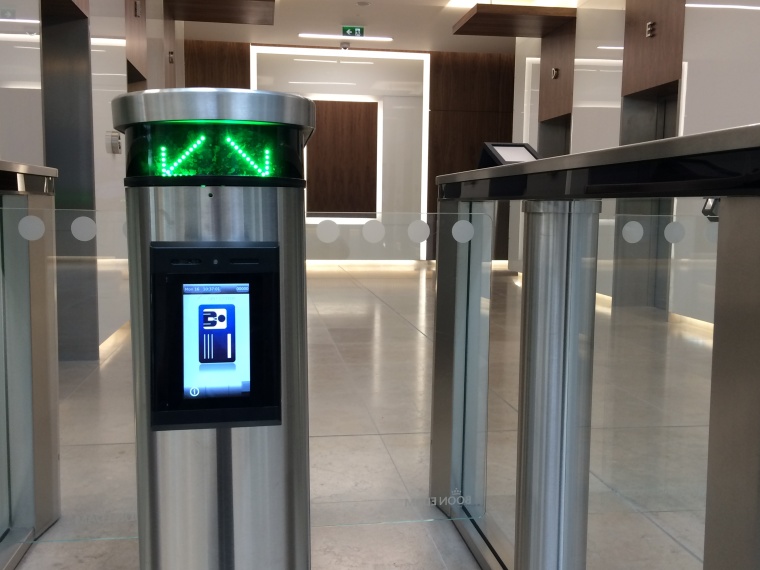Developments in Access Control
There is a lot of talk in the industry about the rise in smart buildings and smart security systems, but what does this actually mean? Philip Verner, EMEA Sales Director at CEM Sys...



There is a lot of talk in the industry about the rise in smart buildings and smart security systems, but what does this actually mean? Philip Verner, EMEA Sales Director at CEM Systems/Tyco Security Products, looks into his crystal ball and gives us his opinion on the trends to watch in access control and the smart developments that are already taking place right now.
There are many trends and topics which will dominate the security industry this year. These include the growth of smart security systems and intelligent smart applications which add value beyond security, as well as the growing use of mobile credentials, wireless/offline locks and multi-modal biometrics. There will continue to be challenges within the industry such as the move from legacy technologies to a more secure smart card or an alternative form of credential, and with more and more manufacturers moving into areas that typically were not their core business, we will continue to see the adoption of more open standards and greater cross industry co-operation.
Smart Buildings and Smart Intelligent Security
With the incorporation of information technology and the Internet of Things (IoT), businesses are effectively getting smarter in everything they deploy. Going beyond the physical security realm, the access control system needs to pay for itself and to add real measurable value to businesses. This can be achieved by either reducing operational costs by combining the use of several devices into one multi-functional unit, or by enhancing operational efficiencies through the use of intelligent smart applications at the door or the centralized command and control of integrated systems. From a security viewpoint, the access control system and integrated sub systems such as video, fire and intrusion detection need to work smarter together for the user, with systems accurately sharing information and data to optimize total building performance.
A recent example of a CEM Systems smart building deployment is the new iconic One Albert Quay project in Cork, Ireland. Renowned as Ireland‘s smartest building, it has its critical systems including the lighting, heating, power, access control, video, fire detection and fire suppression all connected to enable the smart use of data. As the industry moves more towards preventative security measures, the role of systems integration and the unified gathering of analytics from building data becomes even more profound. After all, Intelligent Security shouldn‘t be about capturing the event after it has happened. 2017 will see the growing use of collaborative building data and analytics to look at vulnerabilities before they happen.
Intelligent Smart Applications
Very often, the access control system is seen as a grudge purchase. To help change this mind-set and to enable the access control system to help pay for itself, CEM Systems has a range of intelligent security products that add business value. This includes the emerald multifunctional access terminal which effectively takes the functionality of numerous security devices and combines them into one powerful terminal. As an intelligent touch-screen card reader and door controller in one, emerald features an internal database, scramble keypad, integrated Voice-over-IP intercom and built-in smart card technology.
However, as an intelligent edge device, emerald goes beyond primary access control functions. Using a range of smart applications run directly on the emerald terminal, users can perform what was historically client PC application functionality right at the door, without the need to install dedicated PC software and licenses. Smart applications include, among other things, a local access app for locally changing cardholder privileges directly on the terminal, an integrated staff time and attendance app, a building entry/exit checklist app where card holders have to answer pre-defined questions before access is granted and a meeting room booking app.
The emerald room booking app eliminates the requirement for a room booking solution separate from the access control system. Here users can easily create and edit meeting room bookings through their Microsoft Outlook exchange calendar or directly on the emerald terminal at the door. This provides a smart, quick and convenient way to ensure efficient meeting room allocation.
It‘s also important to remember that a smart solution doesn‘t always have to be a smart app. Harland and Wolff‘s engineering facilities in Northern Ireland recently deployed CEM Systems S3040 portable hand-held card readers at dry dock areas to enable people counting and “mustering on the fly“ in emergency situations. This created measurable efficiency gains by bringing their evacuation drill mustering time down from 45 minutes to nine minutes.
Traditional and Mobile Credentials
The move away from legacy technologies to using Smart cards is still a challenge in the industry today. CEM Systems will continue to work with customers to migrate them smoothly from insecure technologies to a more secure smart card technology with encrypted algorithms like DESFire EV2, for example. The challenges that small companies face when implementing smart cards are cost and knowledge about the technology. Larger companies will have additional concerns such as how they physically manage the migration process and rollout of the new smart cards; especially when multiple sites and multiple security systems are deployed globally. There is also the overall challenge of new technology compatibility with customers existing systems and the critical decision of whether to opt for pre-personalized smart cards versus customer personalization on site.
Another growing trend in the industry and an example of how access control systems are getting smarter for users is the use of mobile phone credentials. Using smartphones as a form of credential is a viable option and can be used either as a supplement to or as a complete replacement for an ID card. After all, some people forget their ID card, but no-one forgets their phone. The benefit of the mobile credential is that it saves time and the cost of physically sending out an ID card, making it an ideal solution for businesses with remote workers and numerous remote sites. Obtaining a card from one central location can be a hindrance as it is often a distance away. Rather than users having to visit the ID unit to obtain a card, they simply download an app via the iOS or Android platform store and the credential is swiftly sent to their smartphone and enabled via email.
Frictionless Versus Multi-modal Biometrics
In a perfect world, the ultimate goal is frictionless access control where the door is smart enough to know that you are the right person going through the door without an ID having to be presented. Although technology continues to progress to support non-credential access control, for obvious reasons we are not there yet. The use of wearable technology such as the smart watch is a growing trend, but there are limitations on the practicalities of its use as required NFC (Near Field Communication) capabilities are not deployed in most watches.
To ensure the highest possible level of security and in the light of the growing vulnerabilities of card cloning, biometric deployments are continuing to grow. The biometric industry is exploding in terms of reliability and availability of sophisticated products, with many now becoming technically and financially viable. Speech and voice recognition without an ID card is gaining popularity, along with facial recognition. However, biometrics does have its limitations in certain environments. For example, within airports there are many light areas and shadows where the accuracy and quality of the facial read can be greatly affected and reduced.
Biometrics always come with challenges and trade-offs. Customers opting for biometrics must analyze cost and the level of security required versus its reliability in terms of false rejection and acceptance rates. To overcome biometric reliability challenges within the industry in general, we are now seeing the growing deployment of multi-modal (dual) biometrics as a more sophisticated and reliable biometric option. To ensure higher levels of reliability, 2017 will continue to see dual biometric checks like Iris and Face or Fingerprint and Vein being deployed at the same time. The combination of the two biometric options gives users a much superior read, and the fusion of these two technologies provides low failure to enroll rates.
CEM Systems also continues to overcome challenges in a number of ways. In addition to having our own fully integrated access control and biometric enrolment solution, we have partnered with third party biometric providers such as Safran Morpho to develop high level integration of Finger and Vein readers at the software enrolment level. Here Morpho Access biometric enrolment is seamlessly integrated into the AC2000 access control system software. This integrated process means a quicker biometric read time, less errors at the door and ultimately less lines of throughput traffic/queues at access control points.
Wireless and Offline Locks
More and more businesses are securing doors with a hybrid approach; using high security doors equipped with intelligent card readers and typically less secure areas – that perhaps wouldn‘t previously have been secured – now fitted with wireless locks. The wireless/offline locks trend will indeed continue to grow throughout 2017 as we see its installation into areas such as server room racks and cabinets. With wireless locks data and analytics fully integrated into the access system for central monitoring and reporting, customers have a comprehensive and powerful platform that not only enables the smart gathering of data but also supports the growing trend towards smart buildings.
Industry Partnerships
The security industry is becoming increasingly complex with more and more suppliers now proliferating disparate areas outside of their core business. For example, with the release of the emerald access terminal, CEM Systems is now operating in areas outside of access control, such as the intercom and room booking space. As manufacturers continue to supply and integrate with products from third party partners, the importance of cross industry co-operation becomes even greater. However, it does represent challenges for suppliers. 2017 will continue to see industry players work together to tackle integration software challenges such as maintaining the backward compatibility of integrated systems. We must also ensure that products support industry standards and open protocols, such as the recent Open Supervised Device Protocol (OSDP), which was introduced as an open protocol to replace insecure Wiegand communication between the card reader and door controller.
As technology continues to progress this year, it will be interesting to see by the end of 2017 where we are with regard to pure frictionless access control, as well as the measurable operational gains being reported from smart buildings. It is also likely that ever more industry standards will be introduced. On a personal level, I will be keeping an interested eye on robotics and how that evolves into the security industry, but that trend is for another day.
Business Partner
Johnson Controls - TycoCEM Systems
195 Airpor BT3 9ED
Germany
most read



Intersec Saudi Arabia 2025 Concludes With Record Exhibitor Participation and Strong Industry Engagement
The seventh edition of Intersec Saudi Arabia showcased 434 exhibitors from 40 countries and welcomed 23,894 attendees

GIT SECURITY AWARD 2026 - The winners have been announced!
GIT SECURITY AWARD 2026: The best safety and security solutions of the year - now an overview of all winners

Security management, building security & perimeter protection: the winners of category E at the GIT SECURITY AWARD 2026
GIT SECURITY AWARD 2026: Security management, building security & perimeter protection - an overview of the most innovative solutions








